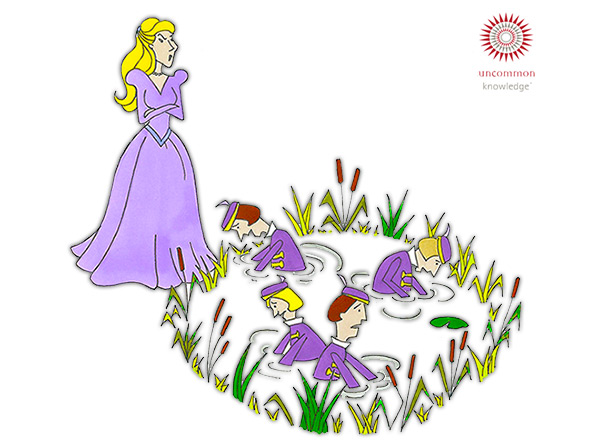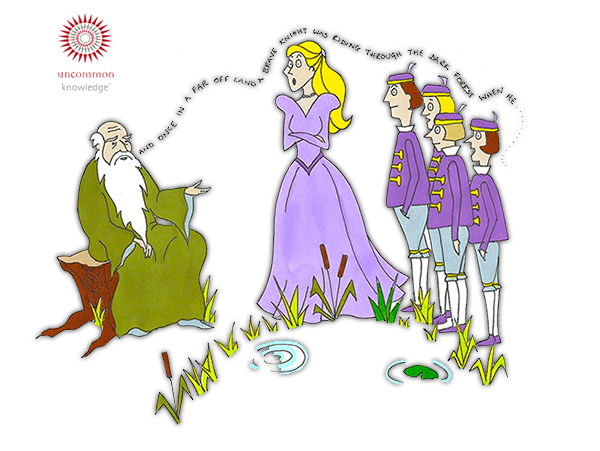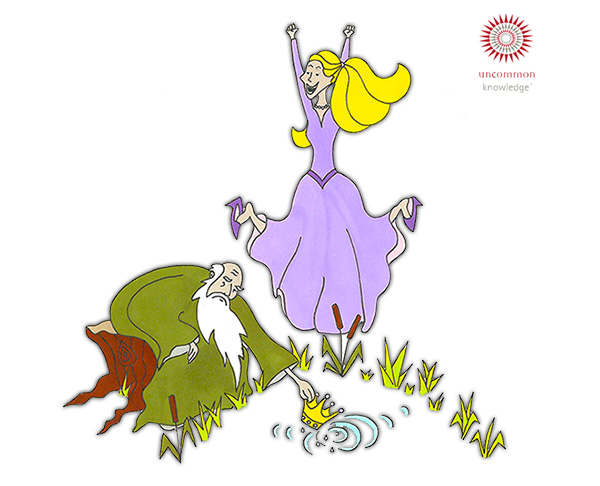Once upon a time, a beautiful princess sat at the edge of a clear, ornate pool in her palace grounds. As she leaned over to gaze at her reflection, her priceless crown tumbled from her head and into the water with a loud splash.
At the sound of her all-is-lost scream, royal attendants rushed to her from all sides. Frantically, they jumped one after the other into the pool, thrashing about in search of the precious object.

Of course, all this effort did nothing but churn the water and swirl up a lot of mud and rotten debris from the bottom of the pool. The water grew murky. The crown disappeared from view. The princess and her attendants panicked.
Now, who should come upon this chaotic scene but the palace storyteller, a bent and bowed old man with twinkling eyes.
With one glance, he took in the chaos. Rather than join the maelstrom, he sat calmly down at the princess’s side and immediately launched into a riveting tale of times gone by.
His sonorous voice wove such a fascinating tapestry of love and adventure that the aides climbed out of the pool to sit down nearby and listen raptly. And the princess herself stopped shrieking, forgetting all about the lost crown.

By the time the storyteller came to the end of his elaborate, embellished tale, everyone and everything – even the mud in the pool – had settled down.
And so, the storyteller reached into the pool, once again still and clear, and easily plucked out the now plainly visible crown.

The princess and the premature conclusion
It can be all too human to jump in too fast to fish out the meaning behind something.
For instance, it’s not always immediately clear why someone is taking longer than usual to reply to your email or why they made a certain comment.
Some people, much like the royal storyteller, can calmly sit with a meaning vacuum and wait for clarity to come along later. They may even accept it’s possible they’ll never truly understand what happened.
But when we prematurely stamp meaning onto an event, we lose a golden opportunity to understand it.
Now what does this have to do with our therapy or counselling clients?
Rushing to muddy the meaning
Emotion triggers the imagination, which isn’t a bad thing in itself.
But problems can develop if we get into the habit of automatically believing that what we imagine is the whole truth, rather than just one possible interpretation of reality.
People overwhelmed by strong emotions such as depression, anxiety or anger tend to rush to fill any information gap with negative meaning and then believe that assumed meaning as unshakeable truth.
They may believe that an emailed response is slow to appear because the other person is angry with them or instantly interpret an unclear comment as some kind of criticism.
And of course this way of thinking just makes our clients feel worse!
There’s a real art to developing the capacity to wait (and relax with waiting) for meaning to become clearer in its own time.
Here are 3 tips to help your clients learn to relax with the wait for clarity rather than rushing to judgment
1) Cast subtle doubt
If your client tells you that her friends have started avoiding her since she became depressed because she is such terrible company, rather than risk breaking rapport by forcefully disputing irrational beliefs, you can gently ask evidence-seeking questions such as:
- Have any of them actually told you this?
- Have you overheard your friends talking about you in this way?
- Have you asked them why they haven’t been to see you?
- Could that be the depression talking, or do you have proof that this is why you haven’t seem them for a while?
Or, even more subtly, you might nod your head empathetically while someone is talking to you about their life and problems. But if they start saying how “everybody at work hates me”, stop nodding.
This sends an almost subliminal signal that there may be something here we can be less sure of.
Prefer to watch instead?
Notice that this is not about telling people they are wrong – they may be right, after all. But when you suspect that people are filling in a meaning gap without enough real evidence, you can cast a little doubt here and there.
2) Ask them to generate other possible interpretations
If you text your friend or leave a message and they don’t get back to you, you could leap to the conclusion that they hate you.
But is that the only conclusion you can draw?
How about:
- Their phone battery is dead.
- They’ve left their phone at home.
- Or lost it.
- They’re swimming.
- Or in a movie theatre.
- Or having a huge fight with someone and can’t check messages.
- Maybe they forgot to turn their ringer back on after work.
Who knows? One thing’s for sure – you don’t. There’s simply not enough information to draw any conclusion.
If a client gives you interpretations of events that are clearly damaging them, you can help them ‘train their brain’ into more helpful flexibility by asking them to generate lots of different possible explanations.
This gets their brain to free itself from its normal assumptions and expectations and to develop the capacity to ‘hold off’ until the facts make themselves known.
3) Draw a distinction between ‘believing’ and ‘knowing’
You believe (I’m guessing) that the earth travels around the sun and you have pretty good reasons to believe this. But you know, from personal experience, that it hurts when you stub your toe against a door.
Some beliefs have more supporting evidence than others, but knowledge has to do with direct experience. The trouble is that belief can easily masquerade as knowledge, so we need to remember the difference.
You can talk to your clients about the difference between belief and knowledge and/or you can just imply by the language you use that there is a difference.
For example:
Client: I know she hates me now!
You: What are the main reasons you believe this?
Sometimes disputing irrational beliefs hinges on that final word – belief.
Because ultimately, just like the storyteller who retrieved the crown from the pool bottom, we all need to be able to wait patiently and let things calm down. Then we can clearly see what there is and what – if anything – we should do about it.










